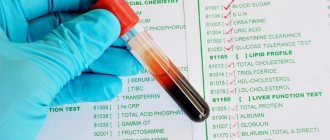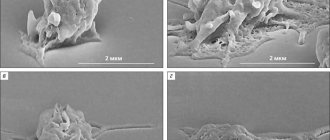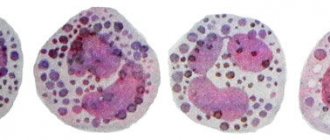One of the components of a detailed blood test is such a parameter as the average platelet volume. These small blood platelets perform important functions in the body: they take part in blood clotting, ensure the formation of a blood clot and restore the integrity of the vessel. In fact, they are not cells, although they are commonly called that. They are disc-shaped fragments of cytoplasm that do not have a nucleus. They are formed in the bone marrow, two thirds are in the bloodstream and one third in the spleen.
The average platelet volume is the platelet index, which characterizes the maturity of blood platelets, the lifespan of which is about 10 days. In blood tests it is designated as MPV. Old cells decrease in size, while young cells, on the contrary, increase in size.
Blood for MPV is donated in the morning on an empty stomach, taken from a vein or from a finger. The analysis result is obtained using hematological analyzers. They draw a curve that shows the distribution of platelets by volume. The histogram is shifted to the right if immature forms predominate. If the blood contains predominantly old cells, a shift to the left occurs.
What is blood morphology and MPV
Morphology is the main diagnostic blood test, which consists of a quantitative and qualitative assessment of blood components.
During this study, the following parameters are determined:
- red blood cells (including reticulocytes, i.e. immature forms)
- hemoglobin
- white blood cells, including: granulocytes, lymphocytes, monocytes and NK cells
- platelets and MPV
MPV is the mean plasma platelet volume .
These are elongated, non-nuclear cells that are responsible for blood clotting processes. This measure indicates the size of most platelets found in plasma. If it deviates from the norm, it may be a sign of various diseases.
Heart and vascular diseases - general information on News4Health.ru
Cardiology is a field of medicine that studies the vital system of the human body - the cardiovascular system: the structural features and functions of the heart and blood vessels, the causes and mechanisms of pathology; develops and improves methods for diagnosing, preventing and treating cardiovascular diseases. Considerable attention in cardiology is paid to the rehabilitation of patients with cardiovascular pathology. Unfortunately, heart and vascular diseases have an increasing tendency to affect young people and represent one of the most important problems of modern health care.
Practical cardiology is developing in two directions: therapeutic cardiology and cardiac surgery. Therapeutic cardiology uses conservative methods (medicines, sanatorium treatment) for the treatment of cardiovascular diseases: bradycardia, tachycardia, arrhythmia, extrasystole, vegetative-vascular dystonia, vascular atherosclerosis, arterial hypertension, angina pectoris, myocardial infarction, coronary heart disease, heart failure, myocarditis, pericarditis, endocarditis.
Surgical cardiology surgically eliminates congenital and acquired heart defects and other lesions of the heart and blood vessels, and performs prosthetics of heart valves and vessels.
Cardiovascular diseases are currently considered the most common cause of disability and early mortality in economically prosperous Western countries. According to statistics, the mortality rate due to cardiovascular diseases is 40-60% annually of the total number of deaths.
The main symptoms that allow one to suspect the development of cardiovascular diseases are pain arising behind the sternum and radiating to the left shoulder or scapula, shortness of breath, persistently elevated blood pressure (BP over 140/90 mm Hg), tachycardia (heart rate more than 100 beats per minute) or bradycardia (pulse less than 50 beats per minute), interruptions in heart rhythm, edema. When the first signs of heart and vascular diseases appear, in order to avoid the development of persistent disorders and complications, you must immediately contact a cardiologist. In the initial period of disease development, restoration of functions is achieved more easily and with smaller doses of drugs.
Currently, cardiology has reached a new level in terms of being equipped with the most modern equipment for quick and early diagnosis and timely treatment of cardiovascular pathology. The main diagnostic methods in cardiology are: phonocardiography, electrocardiography (ECG), echocardiography (ultrasound of the heart), daily ECG monitoring. They allow you to assess the contractile function and condition of the heart muscle, cavities, valves and blood vessels of the heart. Over the past few decades, new methods for examining patients with cardiac pathology have been actively developed: probing of the heart cavities and angiocardiography, which allow diagnosing and planning operations on the heart and coronary vessels.
Modern technologies and methods of treating cardiac pathology make it possible to cope with heart diseases that were considered incurable just yesterday. With the help of heart transplantation, cardiology today saves the lives of many desperate patients.
The main directions in the complex of preventive measures to prevent heart disease are optimal physical activity, giving up bad habits, eliminating nervous overload and stress, healthy eating and proper rest.
Who should check the MPV level
A general blood test is one of the most common tests that is prescribed to rule out various diseases or find out their causes.
The MPV indicator (as well as other platelet tests) should be evaluated in people who:
- experience frequent nosebleeds
- have prolonged monthly bleeding
- have problems healing small skin cuts
- prone to bruising and hematomas
- have petechiae on the skin or mucous membranes
- noticed blood in the stool
- underwent surgery
- have chronic liver or kidney disease
- suffer from cardiovascular diseases
- have used hormonal contraception for many years
- are taking anticoagulants
How to treat elevated MVP?
If a clinical blood test indicates an increase in MVP, you need to find the underlying cause. If it is physiological and characteristic of a given individual, then no measures are taken as such.
In case of pathologies, therapy is provided in a complex form:
- Blood thinners. Used to normalize blood to its natural thickness,
- The use of hormonal treatment for normal platelet production,
- Drinking large amounts of water and diuretics,
- Diet.
In life-threatening situations, doctors perform hemodialysis. A person’s blood passes through a device that retains platelets, as a result of which the level returns to normal.
If the platelet production disorder is caused by the bone marrow, a bone marrow transplant is performed.
MPV too low
An MPV that is too low means that the platelets in the blood are smaller than normal platelets. This may be due to inefficient production in the bone marrow.
This situation occurs as a result of:
- aplastic anemia
- myelosuppression (suppression of bone marrow function – for example, after chemotherapy)
- diseases associated with bone marrow depletion
A decrease in MPV may also indicate:
- deficiency of B vitamins (in particular folic acid)
- taking certain medications (such as antibiotics)
- leukemia
Treatment
If the test shows that your platelet level is below normal, you should undergo testing to find out the reason and decide how to increase your level. Treatment depends on the cause of this condition and is aimed primarily at eliminating it.
If the low platelet count is due to medications, they are discontinued. If severe bleeding occurs, platelet and plasma transfusions are performed. With significant blood loss and the development of severe anemia, transfusions of red blood cells and plasma may be required. To increase platelet production and suppress autoimmune reactions, immunoglobulin and corticosteroids are prescribed.
If there is no desired result with conservative treatment of thrombocytopenic purpura, heavy repeated bleeding, hemorrhages in important organs, splenectomy may be indicated - an operation to remove the spleen, the effectiveness of which is high (about 80%).
For thrombocytopenia, in order to strengthen the walls of blood vessels and increase blood clotting, a course of medications based on natural ingredients can be prescribed. These include products such as Derinat, Sodecor, and Etamzilat.
If your platelet count is low, doctors recommend eating right. It is necessary to avoid alcoholic drinks, hot and spicy foods. The menu should include more foods rich in vitamins A, C and promote better blood clotting. These are liver, fish oil, chokeberry, bell pepper, celery, green apples, parsley, rose hips, carrots, peanuts, pine nuts, almonds, grape and lingonberry leaves, birch sap.
In addition to proper nutrition, doctors recommend adhering to a healthy lifestyle, maintaining a daily routine, getting enough sleep, and not overexerting yourself physically and psychologically.
Video about the functions of platelets and the reasons for the decrease in their number in the blood:
What indicators to check if MPV is outside the norm
The MPV parameter is useful in diagnosing various diseases related to the system that is responsible for blood clotting processes. It is important, however, to keep in mind that MPV is not the only measure of these processes.
It is necessary to analyze it along with other indicators related to blood cells:
- PDW – level of platelet anisocytosis; informs about the percentage of platelets that deviate from the rest in volume;
- PLT – platelet count in blood serum;
- P-LCR – percentage of large platelets.
In most cases, if abnormalities in the blood picture concern only the MPV index and not other parameters, there is no cause for concern. However, any deviations in morphology should be consulted with a physician.
Average platelet volume is reduced
Platelets are elements of the blood that play an important role in clotting. Under certain pathological conditions, the average volume may decrease. To accurately determine the cause of the decrease in volume, a detailed examination must be carried out.
Formation of a primary plug and stopping bleeding
Normal indicators
The following values are considered normal values for the total platelet count:
- adult men and women - 150-400x109 cells/l;
- women during menstruation - 75-220x109 cells/l;
- children - 100-480x109kl/l.
Indicators may vary depending on the individual characteristics of the person. During pregnancy, your platelet cell count may fall. It is recommended to undergo analysis periodically in order to know your personal norm and, if necessary, detect deviations from the usual values.
Normal average volume is 7-10 Fl. In men, the average volume is slightly more than 10-11 Fl. The indicator is reflected in the general analysis. Based on the results of the study, the state of human health is judged.
More details about platelets, their number and average in the video:
Prevention
It is necessary to regularly monitor blood composition. This will help to identify serious violations in time. You should consult a doctor for an analysis if bruises often appear, the skin changes color, you feel constant fatigue, tachycardia, or there is causeless weight loss. If you have chronic diseases, it is recommended to donate blood every 3 months.
To prevent hematopoietic disorders, you need to eat right, replacing animal fats with vegetable ones. It is also necessary to maintain a drinking regime and not take any medications without a doctor’s prescription.
Determining the platelet index or MPV helps to detect pathological changes in the body in a timely manner. If deviations from the norm are detected, the doctor will prescribe treatment.










